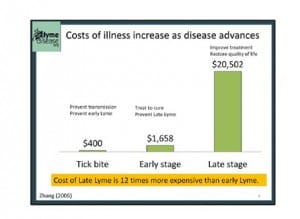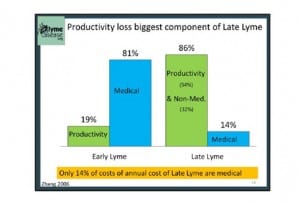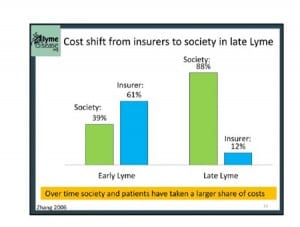Will MA Governor Charlie Baker be on the right side of history?

Photo Credit: Angela Rowlings, The Boston Herald
LymeDisease.org writes to Governor Baker urging him to sign the insurance bill
Massachusetts Governor Charlie Baker has a few days to sign or veto the Lyme insurance bill patients and legislators have been working on for several years. It’s been a roller coaster ride for advocates. The first time the bill went to Baker embedded in a budget bill. He took the opportunity to rewrite the language, turning the patient-friendly legislation into a very bad bill that would have limited patients’ options and made it harder for them to obtain treatment.
Thankfully, the legislature rejected Baker’s amendment and sent him back the original language. This time if he signs it, all is well and Massachusetts will be the second state in the Union (after Rhode Island) to give insurance coverage for treatments doctors decide is best for their patients. If he vetoes it, legislators have three days to override, but they must have a super majority. If he does nothing, it passes by default.
It’s a nailbiter. LymeDisease.org is encouraging Gov. Baker to do the right thing. After all, one legislator said it would only cost insurance companies an extra 11 cents per policy to provide this coverage for people with Lyme. (This figure was obtained through a cost analysis that was commissioned by the legislature and performed by an independent agency.)
Here is our letter, sent yesterday. It’s not too late for you to call or write. See ACTION ALERT below.
EXECUTIVE SUMMARY
RE: Bill H.4491, an Act relative to Lyme disease treatment coverage
- One in 25 Massachusetts residents has Lyme disease. More than 300,000 Massachusetts residents have been affected by Lyme disease since 2005. Everyone knows someone with Lyme disease.
- Lyme disease costs Massachusetts patients more than $940 million annually in excess medical costs alone compared to people who have not been diagnosed with Lyme.
- Patients are angry about not being treated fairly when they are sick. The refusal of insurance companies—based on their interpretation of outdated guidelines—to pay for treatment discriminates against the sickest patients.
- Costs associated with Lyme can be minimized if treated early and sufficiently, but non-medical and loss of productivity costs increase exponentially if the disease becomes chronic (averaging $11,000 per patient, or $1.7 billion in the state annually).
- Patients and their doctors should be free to decide which treatment is best suited to their individual situation. Insurance needs to cover treatments the doctor orders.
- In the current climate, treatment beyond four weeks is common, but insurance rarely pays. Extended treatment is often successful and is not dangerous. The bill does not mandate any particular treatment.
- LymeDisease.org has a finger on the pulse of the Lyme community. At the moment patients are extremely unhappy about the possibility that you may veto their bill.
PO Box 1352
Chico CA 95927
July 22, 2016
The Honorable Charles D. Baker
Governor, State of Massachusetts
Massachusetts State House
Room 280
Boston, MA 02133
Dear Governor Baker,
I am writing on behalf of LymeDisease.org, a leading national patient advocacy organization, to urge you to sign the Lyme Insurance Legislation, H.4491.
As you know, the practice of medicine is not a cookbook science, but rather requires a patient-centered, individualized approach. This is especially true in the complicated and highly personalized treatment needed for Lyme disease. However, many patients cannot get the help they need because their health insurance refuses to pay for their treatment. Lymedisease.org believes that decisions about medical treatment should be between the patient and his or her doctor. To give fiscally motivated insurance companies power to deny care, especially long-term care, takes away physicians’ ability to use their clinical judgment and damages patient lives.
About LymeDisease.org
LymeDisease.org is the number one trusted source of information in the Lyme community and has the largest internet presence among all the grassroots Lyme organizations. We have been actively promoting patient interests since 1989, with surveys, a big data research project, educational events, website, a journal, and political action. Over four million people visit our website annually while our Facebook and Twitter reach tens of thousands more. LymeDisease.org also hosts online state groups across the country. Our Massachusetts group is large and active.
We have collaborated with several states on legislation to enable doctors to use their clinical judgement when treating Lyme patients who do not recover after short-term treatment. We have worked with CA legislators to pass a number of bills improving care of people with Lyme in California.
LymeDisease.org was invited to testify at a hearing on Lyme disease conducted by the Institutes of Medicine (IOM) in 2010. A subsequent IOM hearing on developing trustworthy guidelines led to the Infectious Diseases Society of America (IDSA) being held up as an example of a guidelines process gone wrong. In 2015 we participated in a meeting on precision medicine at the White House, and earlier this year we spoke at the annual meeting of the American Academy for the Advancement of Science in Washington, DC.
Which guidelines?
Many insurance companies cite the guidelines issued by the IDSA as their justification for denial of coverage. The IDSA is the private medical society responsible for the myth that Lyme is curable with a few short weeks of antibiotics. In 2006, we worked closely with then-CT Attorney General Blumenthal’s office to initiate a civil investigation of the IDSA that resulted in the censure of that organization. (http://www.ct.gov/ag/cwp/view.asp?a=2795&q=414284) Their guidelines are out of date and have been delisted by the National Guidelines Clearinghouse.
The only guidelines currently listed by the National Guidelines Clearinghouse are from the International Lyme and Associated Diseases Society (ILADS). They are patient-centered and advocate that physicians should use their clinical judgment to create individualized treatment plans for their patients, including extended treatment in selected cases. Additionally, the guidelines follow a systematic and transparent analysis of the evidence used by the Cochrane Collaboration and the WHO and comply with the eight standards identified by the Institute of Medicine as being critical to trustworthiness.
Lyme costs accrue to patients and society, not insurance companies
In 2013, when MA legislators were first working on this bill, LymeDisease.org’s CEO, Lorraine Johnson, JD, MBA, presented a slide show about displaced costs in the context of Lyme disease and insurance coverage. ( https://www.lymedisease.org/lyme-basics/resources/massachusetts-insurance-legislation-lyme-disease/ ) Her research was based on the results of surveys conducted by Lyme disease.org and the findings of a study by Dr. Zhang of the CDC published in 2006. Since that time, another major cost-of-illness study has been done by John Aucott and colleagues at Johns Hopkins. I share some of her slides below.
The findings of these studies show that patients diagnosed with Lyme disease pay an average of $3,000.00 more in annual medical costs than those who have not been diagnosed with Lyme. They have more doctor visits and hospital admissions than healthy people.[1] Lyme disease costs as much as $2 billion per year for medical costs alone. These figures don’t include the thousands who have Lyme disease, but have not been properly diagnosed or patients diagnosed in previous decades. And they don’t include non-medical costs.
Most of the increased cost growth in healthcare in the United States is associated with chronic conditions.[2] Over 80 percent of the costs of health care spending in the United States is related to chronic conditions. Since so many Lyme patients—up to half—become chronic (referred to as either “chronic Lyme” or “post-Lyme syndrome”) this becomes a critical consideration.
Medical insurance is only responsible for direct medical costs—the loss-of-productivity costs are borne by the patient, the family, the community and ultimately the government through lost tax revenues, lowered gross domestic product, and disability support payments. In Massachusetts these costs are estimated at $1.7 billion per year.
The Zhang study found that the cost of Lyme disease increases exponentially over time. As shown, if treated effectively at tick bite, the cost is quite modest. However, once the patient reaches Late Lyme or chronic Lyme, the costs skyrocket.[3]
Unfortunately, we are not diagnosing Lyme early, when it is more easily treatable and the cost are low. In our surveys of patients with chronic Lyme, 84 percent were not diagnosed early and this late diagnosis was a major factor in their development of chronic Lyme disease. The average time between infection and diagnosis was four years.
Short-term treatment not effective
A CDC-funded study by Dr. S.A. Hook and colleagues found that the majority of patients were being treated for more than four weeks and 36 percent were being treated for more than eight weeks.[4] Clearly, short term protocols are not working, even for early disease. When people are undertreated, costs mount up.
Our survey of over 4,000 patients with chronic Lyme found that 65 percent had to cut back on work or school at some point in their illness. Forty-four percent had to quit working altogether and another ten percent had to shift from full time to part time work. These people are not only unable to work and support their families, they also exact a high societal cost. One of our published studies found that 25 percent of patients with chronic Lyme had been on public support at some point.[5] Of those who have received disability at some point, 75 percent had been on disability for more than a year, 37 percent for more than five years, resulting in a huge drain on public resources.
Zhang explains that the percentage of medical cost for early Lyme is quite high, while those for late Lyme are relatively low. As shown, the medical costs in Late Lyme are only 14 percent of the total costs while 86 percent of the costs are either loss of productivity or non‐medical costs, like caretakers.
Insurance companies pay less for late Lyme
Not only are the annual costs of early Lyme small ($1,600) compared to the annual costs of Late Lyme ($20,000), but in early Lyme almost all of the cost is medical and, as shown in the chart below, is born by insurers. Contrastingly, in Late Lyme almost all of the cost is borne by patients, families, communities and, ultimately government. Insurers deny coverage and reduce their costs at the expense of patients and society. We believe it is time to ask the insurers to start paying their fair share and H.4491 is a step in that direction.
Over the past ten years, more than 300,000 Massachusetts residents have contracted Lyme disease, almost five percent of the state’s population. Everyone knows someone with Lyme disease and many have loved ones who are affected by this terrible disease. Our followers have spoken and they want you to sign this legislation. The bill does not dictate treatment or compel doctors to treat in any particular way, nor does it place an undue burden on insurance companies. However, it provides much needed relief to a large, suffering population that is likely to increase as prevention methods do not work and current treatments are only marginally effective.
H.4491 was designed to help patients deal with the crippling costs of Lyme and agreed upon by legislators and thousands of Massachusetts patients. Governor Baker, please let Massachusetts lead the country with this common sense legislation. If you or a loved one contracted Lyme disease, wouldn’t you want your doctor to be able to prescribe whatever he, in his clinical judgment, felt was right for you, instead of trying to fight with one hand tied behind his back?
Sincerely,
//Phyllis Mervine
Phyllis Mervine, President
Lymedisease.org
[1] Adrion ER, et al. Health care costs, utilization and patterns of care following Lyme disease. PLoS One. 2015 Feb 4;10(2):e0116767. doi: 10.1371/journal.pone.0116767. eCollection 2015.
[2] DeVol, R, Bedroussian, A. An Unhealthy America: The Economic Impact of Chronic Disease. 2007.
[3] Zhang X1, Meltzer MI, Peña CA, Hopkins AB, Wroth L, Fix AD. Economic impact of Lyme disease. Emerg Infect Dis. 2006 Apr;12(4):653-60.
[4] Hook SA1, Nelson CA2, Mead PS.3 U.S. public’s experience with ticks and tick-borne diseases: Results from national HealthStyles surveys. Ticks Tick Borne Dis. 2015 Jun;6(4):483-8. doi: 10.1016/j.ttbdis.2015.03.017. Epub 2015 Apr 15.
[5] Johnson L1, Aylward A, Stricker RB. Healthcare access and burden of care for patients with Lyme disease: a large United States survey. Health Policy. 2011 Sep;102(1):64-71. doi: 10.1016/j.healthpol.2011.05.007. Epub 2011 Jun 14.
ACTION ALERT
Related posts
MA Lyme insurance bill is down to the wire
Update on MA Lyme insurance bill–prepare for override?
Breaking news–MA Lyme insurance bill goes back to governor
Update on MA Lyme insurance: use Voter Voice now
Down to the wire in Massachusetts–action alert
MA residents: Lyme insurance mandate needs your help now
Massachusetts residents, please contact your governor now
Massachusetts doctors’ group opposes Lyme insurance bill; advocates respond
MA House Includes Linsky Provision to Provide Treatment Coverage for Lyme Disease Sufferers
























Unfortunately insurance companies are only in for the profit. Good at taking your money however when it comes to paying they hold the reins & say hold on it is very sad. I live in PA & also had Lyme’s misdiagnosed by two doctors as a spider bite & giant hives my two friends who degrees in epidemology [sp] diagnosed what I had from the quarter size blotched [not raised ] rash on my chest they called the doctor who they knew & they immediately started me on Doxie [for 30 days] the rash started to fade & disappear immediately.
Thank you, Phyllis and Lymedisease.org for recognizing how important this bill is and stepping up once again for Lyme patients. Massachusetts prides itself in providing health care for all its citizens. While the MA legislature has shown an understanding of the true cost of having a large percentage of its citizens disabled by a treatable illness, it seems like Governor Baker is ill informed and still thinking like the insurance executive that he once was. Governor Baker, we are in the middle of an epidemic and lives are being wrecked, including those of thousands of children, it is time to step up and protect the citizens that elected you. Lyme patients have a right to be treated by the board-certified license physician and the “medically accepted standard of care” of their choice.
Thanks for writing, Karla. LymeDisease.org stands with you and Lyme patients everywhere to end this unconscionable discrimination against desperately sick people.
Well written letter to Gov Baker. I sure hope he does the right thing. We need these dominos to start to fall…
I agree, Jean. Thanks for writing.
My Lyme started in the mid 1950s. LONG before anyone knew of it or it had a name. I am 74, male, with a PhD in Biology – my research was focused in the field. My current treatment is weekly gamma globulin infusions to the tune of over $60K per month if I had to self-pay. Thankfully, Medicare and my excellent retirement health insurance cover 100%. I can not skip a dose – or even postpone it for two days. By the end of each week, I am slipping rapidly downhill and need “my fix.” Once the infusion is complete, I lose my ability to do anything constructive for the next 36 to 48 hours until the material is distributed through my system. So, three days a week are wasted – but four days are tolerable.
Al, thanks for writing. I hope you are participating in MyLymeData. https://www.lymedisease.org/mylymedata/
Nice letter, lots of good information explained clearly. Lets hope he does the right thing snd signs the bill.